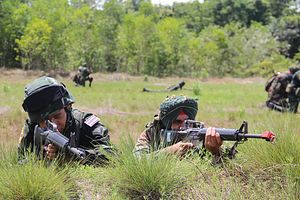A new report from the Center for New American Security (CNAS) details shifts in the balance of military power between India and China, and calls into question whether India is prepared to play the role that U.S. strategists seem wont to assign it. Daniel Kliman, Iskander Rehman, Kristine Lee, and Joshua Fitt have prepared an exhaustive account of India’s military readiness and how that readiness has changed relative to China over the past two decades. As the authors note, “in 2000, India’s military outlays were 66 percent of China’s; by 2017, despite significant absolute growth in India’s defense budget, this figure had declined to 26 percent.”
As the report points out, the United States has decided (over the course of three presidential administrations) to bet heavily on the promise that India could counterbalance the growth of Chinese military power. This has included technology transfers, arms sales, and joint exercises intended to improve readiness and increase interoperability. Unfortunately for Delhi and Washington, Indian military capabilities have grown only slowly, in stark contrast to the massive modernization and expansion of the armed forces of China. The situation has developed to the point that Indian advantages in two key theaters of operations have come under risk. The authors argue that India should strive to maintain a favorable balance of forces in the Himalayas, and maintain advantages along Chinese supply lines in the Indian Ocean.
For example, the rapid expansion of the People’s Liberation Army Navy carries substantial technological risks for China. But the excruciatingly slow development of the Indian Navy exposes India to a different set of risks. India is in the process of squandering its potential advantage in naval aviation (born of both a long heritage of carrier aviation, and of strong defense relationships with the U.S., the U.K., and even Russia) through its slow and haphazard acquisition schedule. This has given China a lot of time to essentially reinvent the wheel. Indian problems extend to other domains as well. The torturous acquisition of 36 Dassault Rafale fighters remains only partially consummated, and even as India made the probably necessary choice to withdraw from the PAK FA joint venture, China’s aviation industry has moved into initial production of the J-20 stealth fighter
The authors further note the problem of Pakistan, which continues to preoccupy India’s strategic attention. Despite substantial advantages in conventional military power and economic weight, the Pakistani nuclear program poses a problem that India cannot solve, only manage. Moreover, Pakistan’s continued willingness to use nonstate actors at low levels of escalation prevents India from fully directing its focus toward China. Of course, China faces problems elsewhere along its periphery, and India has never been required to carry the load on its own.
Overall, the report is well worth a close read, as it includes detailed information regarding India’s military capabilities and its strategic and operational concepts in the relevant theaters. No one expects India to join the United States in a war against China in the event of conflict in the Western Pacific. 2019 is not 1914, after all. But to the extent that India can continue to provide a military problem that Chinese planners need to address, the strategic positions of Japan, Vietnam, the United States, and Taiwan will benefit.

































